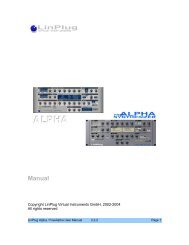CrX4 User Manual - LinPlug Virtual Instruments
CrX4 User Manual - LinPlug Virtual Instruments
CrX4 User Manual - LinPlug Virtual Instruments
You also want an ePaper? Increase the reach of your titles
YUMPU automatically turns print PDFs into web optimized ePapers that Google loves.
dynamically to MIDI input. If you overlap the velocity ranges (for example,<br />
sample 1 is triggered in the 1 to 80 velocity range while sample 2 is<br />
triggered in the 50 to 127 velocity range) you create what is known as a<br />
velocity crossfade. In the crossover region (50 to 80) the volume of one<br />
sample is successively reduced, while the volume of the other sample is<br />
successively increased until only one sample is heard (below 50 and above<br />
80, in this example). Note: the screenshots in this manual do not visualize<br />
this example, as in <strong>CrX4</strong> you always only see one sample at a time.<br />
The most prominent part is the sample display, showing a graphical<br />
representation of the sample. The sample data is drawn in different colors:<br />
dark green represents not-played parts of the sample (which are before the<br />
Start Point). Next is a white sample wave for normal playback and the loop<br />
region drawn in a light green color. Samples behind the loop are agin<br />
shown in white.<br />
To adjust the start and loop point markers click on or near the vertical line<br />
and drag them forth or back. The degree to which the Loop Start and Loop<br />
End can be modulated is adjusted by clicking near the top of the loop's start<br />
point marker (the first, bright red vertical line) and dragging to the right. A<br />
small horizontal rectangle opens, indicating the maximum modulation<br />
range.<br />
The scrollbar at the bottom of the display allows you to scroll the sample<br />
sideways when it is too long to be displayed in the window. This, of course,<br />
depends on the current magnification setting (described a few lines below).<br />
The Reverse setting determines the direction in which the sample is played<br />
back. Normally, samples play from start to end. However, by clicking on this<br />
button sample playback is reversed.<br />
The parameters Start, Loop-Start and Loop-End are the same as in the<br />
main generator window, as described above.<br />
<strong>CrX4</strong> <strong>User</strong> <strong>Manual</strong> 21












